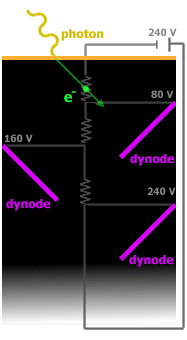
|
The number of secondary electrons emitted is dependent upon the material of the dynode and is proportional to the kinetic energy of the incident electron. Each dynode is held at a potential relative to the next dynode, and this potential gives the incident electron its kinetic energy by accelerating it to the next dynode. The voltage between each dynode is important because it determines the kinetic energy of the incident electron. Incident electrons with higher kinetic energies tend to emit more secondary electrons.
The work done on a charged particle moving through a potential difference is given by: In this case, the work done on the electron is equal to the change in its kinetic energy. If we assume the electron starts from rest (it initially has some velocity, but it is so small compared to the final velocity that we can ignore it), it therefore has no initial kinetic energy--so the work done on the electron is equal to its final kinetic energy.
|
